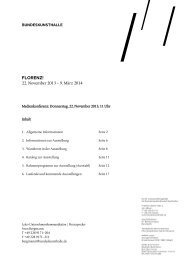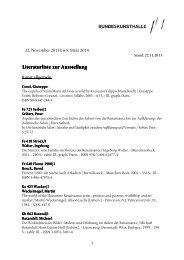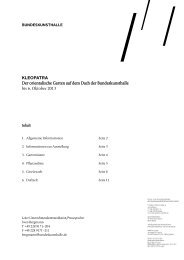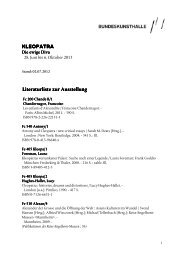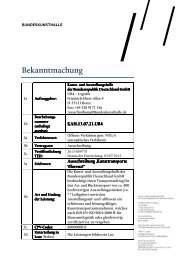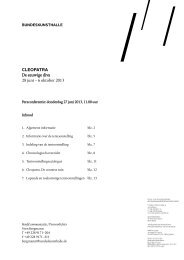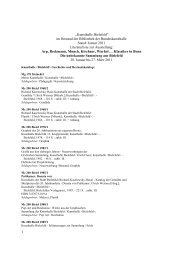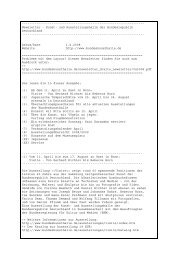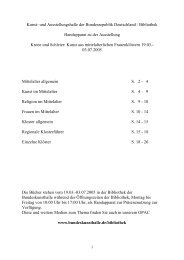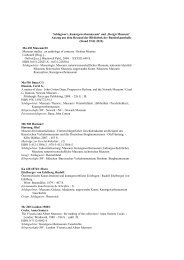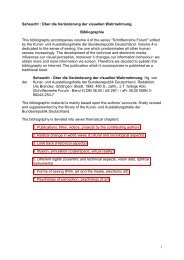Peoples through space and time Archaeology in Germany 09.05 ...
Peoples through space and time Archaeology in Germany 09.05 ...
Peoples through space and time Archaeology in Germany 09.05 ...
You also want an ePaper? Increase the reach of your titles
YUMPU automatically turns print PDFs into web optimized ePapers that Google loves.
A treasure found <strong>in</strong> 1979 <strong>in</strong> direct proximity to the bath house of the strategically important<br />
Weissenburg fort <strong>in</strong> Bavaria gives testimony to the catastrophic situation that existed along the Rhaeto<br />
Limes dur<strong>in</strong>g the Middle of the 3 rd century A.D.<br />
Orig<strong>in</strong>ally buried <strong>in</strong> a wooden crate, the treasure consisted of 114 artifacts, <strong>in</strong>clud<strong>in</strong>g 18 statuettes of<br />
Roman gods, 10 additional figurative bronzes, 11 silver votive panels, four dress helmets, 18 bronze<br />
fitt<strong>in</strong>gs <strong>and</strong> 33 iron tools.<br />
Accord<strong>in</strong>g to the artifacts found, they represented booty from robberies of various Roman house<br />
shr<strong>in</strong>es, a temple <strong>and</strong> a military camp’s banner shr<strong>in</strong>e which Germanic marauders buried <strong>and</strong> for<br />
unknown reasons never recovered.<br />
Excavated Booty <strong>in</strong> Hagenbach<br />
The pillag<strong>in</strong>g of Roman prov<strong>in</strong>ces around 275 B.C. by Germanic maraud<strong>in</strong>g b<strong>and</strong>s is exemplified by a<br />
site discovered <strong>in</strong> a gravel quarry near Hagenbach, situated on the upper Rh<strong>in</strong>e between the legion<br />
camps of Ma<strong>in</strong>z <strong>and</strong> Strasbourg. The site marks the place were the Alemanni lost their rich booty on<br />
their return from Gaul to Germania while cross<strong>in</strong>g the Rh<strong>in</strong>e.<br />
Beside a large number of damaged bronze <strong>and</strong> silver vessels, jewelry, weapons <strong>and</strong> tools, the f<strong>in</strong>d<br />
<strong>in</strong>cluded 129 silver votive panels. The names engraved on the panels <strong>and</strong> the style of ornamentation of a<br />
majority of the artifacts po<strong>in</strong>t to South-Western France as their place of orig<strong>in</strong>. The markedly<br />
fragmented state of this booty shows that the precious metals such as bronze <strong>and</strong> iron were exclusively<br />
robbed for their material worth.<br />
18<br />
From Late Antiquity to the Early Middle Ages<br />
From an archaeological perspective, the period of transition from the 4 th to 5 th century was a dynamic<br />
<strong>time</strong> alternat<strong>in</strong>g between cont<strong>in</strong>uity <strong>and</strong> breaks, characterized by the end of the Roman Empire <strong>in</strong> the<br />
West <strong>and</strong> the rise of the Frankish k<strong>in</strong>gs.<br />
Large graveyards like the one <strong>in</strong> Krefeld-Gellep were used cont<strong>in</strong>uously until the 7 th century. In areas<br />
with a verifiable population cont<strong>in</strong>uity, major breaks tend to be rare. In other areas, such as <strong>in</strong><br />
Northeastern <strong>Germany</strong>, entire regions were deserted.<br />
Archaeologists have discovered that various population groups were highly mobile <strong>in</strong> the 5 th century <strong>in</strong><br />
Southern <strong>Germany</strong>, result<strong>in</strong>g <strong>in</strong> short-term settlements <strong>and</strong> a mix<strong>in</strong>g of foreign elements.<br />
New f<strong>in</strong>d<strong>in</strong>gs <strong>and</strong> modified approaches to the cont<strong>in</strong>uously grow<strong>in</strong>g amount of uncovered material have<br />
ultimately led to an exemplary explanation of the development of Germanic tribes <strong>in</strong> the Early Middle<br />
Ages, who under the leadership of the Frankish k<strong>in</strong>gs determ<strong>in</strong>ed <strong>Germany</strong>’s further history.<br />
Germanic Settlements<br />
The smallest Germanic settlement was the small family-run farm. Hamlets or villages with more than 25<br />
small farmyards were rare. The farms were constructed accord<strong>in</strong>g to the same plan: the ma<strong>in</strong> build<strong>in</strong>g<br />
was mostly enclosed <strong>and</strong> represented comb<strong>in</strong>ed liv<strong>in</strong>g quarters <strong>and</strong> animal shelter.<br />
Other build<strong>in</strong>gs of different functions surrounded the ma<strong>in</strong> build<strong>in</strong>g, such as stilted houses for storage or<br />
pit houses for housework. Wells of various construction styles served the farm with fresh water.<br />
Separated zones for technical facilities such as limework ovens <strong>and</strong> tann<strong>in</strong>g pits were found <strong>in</strong> larger<br />
settlements.<br />
In the past few years our knowledge of Germanic settlements has greatly <strong>in</strong>creased due to<br />
comprehensive excavations particularly <strong>in</strong> Mecklenburg-Vorpommern <strong>and</strong> Br<strong>and</strong>enburg, where more<br />
than 100 partly large-scale archaeological exam<strong>in</strong>ations of settlements from the 1 st to 5 th century have<br />
been carried out s<strong>in</strong>ce 1990.<br />
20




